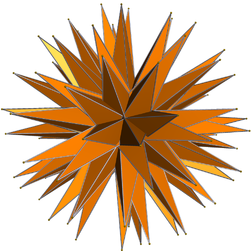| Great pentagrammic hexecontahedron | |
|---|---|

| |
| Type | Star polyhedron |
| Face | |
| Elements | F = 60, E = 150 V = 92 (χ = 2) |
| Symmetry group | I, , 532 |
| Index references | DU74 |
| dual polyhedron | Great retrosnub icosidodecahedron |
In geometry, the great pentagrammic hexecontahedron (or great dentoid ditriacontahedron) is a nonconvex isohedral polyhedron. It is the dual of the great retrosnub icosidodecahedron. Its 60 faces are irregular pentagrams.

Proportions
Denote the golden ratio by . Let be the largest positive zero of the polynomial . Then each pentagrammic face has four equal angles of and one angle of . Each face has three long and two short edges. The ratio between the lengths of the long and the short edges is given by
- .
The dihedral angle equals . Part of each face lies inside the solid, hence is invisible in solid models. The other two zeroes of the polynomial play a similar role in the description of the great pentagonal hexecontahedron and the great inverted pentagonal hexecontahedron.
References
- Wenninger, Magnus (1983), Dual Models, Cambridge University Press, ISBN 978-0-521-54325-5, MR 0730208
External links
This polyhedron-related article is a stub. You can help Misplaced Pages by expanding it. |
 . Let
. Let  be the largest positive zero of the polynomial
be the largest positive zero of the polynomial  . Then each pentagrammic face has four equal angles of
. Then each pentagrammic face has four equal angles of  and one angle of
and one angle of  . Each face has three long and two short edges. The ratio
. Each face has three long and two short edges. The ratio  between the lengths of the long and the short edges is given by
between the lengths of the long and the short edges is given by
 .
. . Part of each face lies inside the solid, hence is invisible in solid models. The other two zeroes of the polynomial
. Part of each face lies inside the solid, hence is invisible in solid models. The other two zeroes of the polynomial  play a similar role in the description of the
play a similar role in the description of the